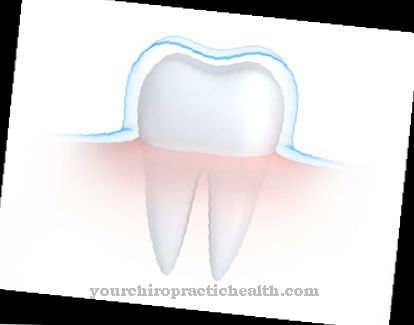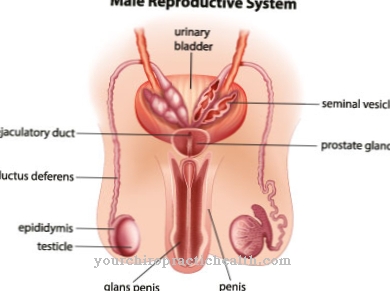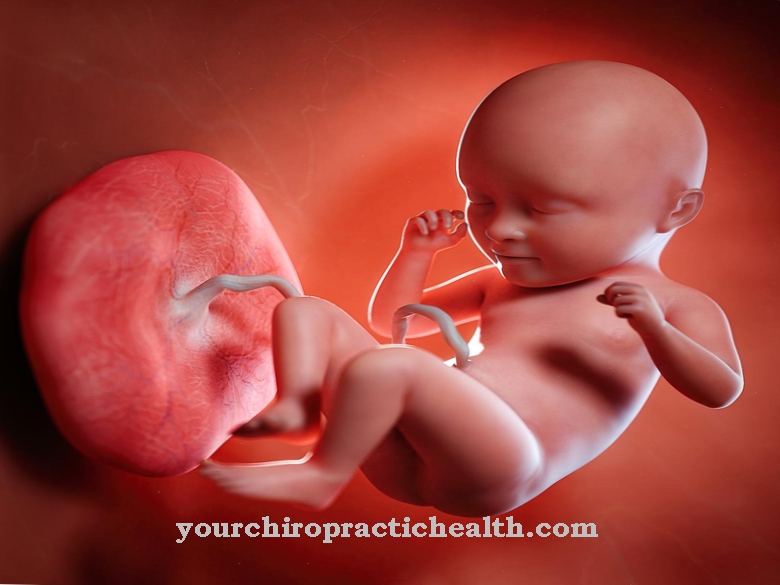A Lipid metabolism disorder occurs when the fat content of the blood exceeds the normal value. This applies to both increased cholesterol and triglyceride levels. Elevated blood lipid levels lead to cardiovascular disorders in the medium to long term.
What is a lipid metabolism disorder?

© blueringmedia - stock.adobe.com
Lipid metabolism disorders (dyslipidemia) describe the shift in the composition of blood fats (lipids). There is usually a pathological increase in cholesterol or triglycerides or both. A Dyslipidemia is a collective term for several disorders of lipid metabolism. Fats can appear in the blood as both esterified cholesterol and triglyceride (normal fat). Cholesterol is colloquially referred to as fat, but it is not a fat. However, it is esterified with fatty acids, which are the main component of fat.
The triglycerides are the fats that are also known as storage fats. Here glycerine is esterified with fatty acids. However, the entire group of substances belongs to the lipids. In order to make lipids transportable, they need transport proteins that bind to the lipids. So-called protein-lipid complexes are formed, which are referred to as lipoproteins. The lipoproteins include the triglyceride-rich chylomicrons, the very low density lipoproteins (VLDL), the low density lipoproteins (LDL) and the high density lipoproteins (HDL).
causes
Which protein-lipid complexes are increased is also decisive for the health effects. An excessively high LDL value contributes to the formation of arteriosclerosis. An increased HDL value, in turn, is even beneficial. It lowers the risk of developing arteriosclerosis. There are primary and secondary hyperlipoproteinemias. The primary forms of the disease are genetic, but mostly only the predisposition is passed on. Whether the disease breaks out depends crucially on the lifestyle.
Obesity, a lack of exercise and a high-calorie diet, in particular, contribute to an increase in blood lipid levels. In addition, this also worsens the ratio of LDL to HDL. Hyperlipoproteinemia is only very rarely genetically fixed in such a way that elevated blood lipid levels are already present at birth. The secondary form of lipid metabolism disorder is the result of an underlying disease such as type II diabetes mellitus, hypothyroidism, kidney disease or liver disease.
It can also be caused by certain medications. Although primary and secondary lipid metabolism disorders have different causes, their consequences are the same. Atherosclerosis develops in the medium to long term.
Symptoms, ailments & signs
In the case of lipid metabolism disorders, there are primarily no complaints. Long before the first symptoms appear, the blood lipid levels can be very high. Gradually arteriosclerosis forms, which constricts or even blocks the blood vessels. The first symptoms can be breathing difficulties with low stress, chest tightness, pain in the right upper abdomen due to fatty liver or even inflammation of the pancreas.
Later on there may be pain in the legs, heart attack, stroke or thrombosis. However, symptoms are not always to be expected even with very high blood lipid levels. Sudden cardiac death from seemingly perfect health is also possible. Signs that are often less noticed are so-called xanthomas and xanthelasma.
These are large or small skin lumps that contain foam cells loaded with cholesterol or fat. A gray-white ring around the cornea in young people is an indication of a hereditary lipid metabolism disorder. A massive increase in hypertriglyceridemia often causes inflammation of the pancreas or red-yellow lumps on the buttocks.
diagnosis
Since lipid metabolism disorders do not initially cause symptoms, they are often also undiagnosed. Therefore, from the age of 35, the blood lipid values should be determined every two years. Hyperlipoproteinemia can then be easily identified. The total cholesterol level, HDL and triglycerides are examined.
The LDL value and the ratio of LDL to HDL can be calculated from these values. More detailed examinations are required if a serious lipid metabolism disorder is suspected. Genetic tests can determine which genetic changes lead to the increased values. In the case of secondary lipid metabolism disorders, the doctor looks for the underlying disease.
Complications
In most cases, a permanent lipid metabolism disorder can have negative effects on the heart and circulation. The risk of a heart attack increases for those affected. In the worst case, death can occur after a heart attack.
As a rule, the patient does not feel any discomfort at the beginning and can only determine this through being overweight. If the lipid metabolism disorder has progressed, breathing problems can occur. This occurs even with the slightest loads. Physical activities or sports are no longer possible for the patient. Sudden death also occurs in some cases.
Treatment is in most cases through a strict diet and healthy lifestyle. There are no complications and the lipid metabolism disorder can be combated relatively well. If the diet is adhered to, the fat metabolism disorder does not occur again. In severe cases, a so-called blood wash is carried out.
If the lipid metabolism disorder cannot be combated permanently, the patient is permanently dependent on blood washing. This leads to considerable restrictions in everyday life, which can also have a negative effect on the psyche. As a result, many patents also suffer from depression and a reduced attitude towards life.
When should you go to the doctor?
Fat metabolism disorders are usually not noticeable for a long time through no symptoms. If the first symptoms appear, damage to the vessel walls has usually already occurred, which, if left untreated, can trigger a heart attack or stroke. A doctor should be consulted immediately at the first signs such as tingling or numbness in the hands and feet, a tightness in the chest when exercising or pain in the legs when walking longer distances.
A circulatory disorder caused by increased blood lipid levels can also hide behind visual disturbances, vertigo attacks, speech disorders or states of confusion.
Small yellowish-brown nodules (xanthomas) on the ears, eyelids, wrists and ankles as well as the buttocks can indicate a congenital lipid metabolism disorder. Such skin changes should be clarified by a doctor as well as a white-yellow-gray ring around the cornea in the eye, which in young people is often caused by a disturbed lipid metabolism. A visit to the doctor is also advisable in the event of persistent pain in the right upper abdomen, which can be triggered by fatty liver.
Occasionally a strong increase in triglycerides, usually genetically caused, becomes noticeable through inflammation of the pancreas, which requires immediate medical treatment due to its severe symptoms with severe abdominal pain, nausea and fever. Healthy people should also have their blood lipid levels checked regularly - this is especially true if close family members suffer from a lipid metabolism disorder.
Doctors & therapists in your area
Treatment & Therapy
The therapy consists first of all in changing the way of life. It is necessary to change your diet. The dietary fat content in the diet should be below 30 percent. It is also important to ensure that there is a sufficient supply of essential unsaturated fatty acids. In the case of obesity, reducing excess weight has absolute priority. In addition to the change in diet, physical activity should not be neglected.
Smokers should give up smoking immediately. If, despite these conventional measures, the blood lipid levels do not fall, drug treatment offers a good chance of normalizing the levels again. Statins are one of the most important fat-lowering drugs. They inhibit the production of LDL in the liver. The cholesterol level can be reduced by up to 50 percent. However, the medication only works after several weeks.
In parallel to drug treatment, the reduced-fat diet should be maintained. If both lifestyle changes and drug treatment are unsuccessful, blood washing can be performed. This treatment is also known as lipid apheresis. This treatment removes blood lipids from the blood. As with dialysis, blood washing must last for a lifetime.
Outlook & forecast
The prospect of a cure for a lipid metabolism disorder depends in many cases on the patient's state of health and the patient's willingness to change their existing lifestyle. People who are heavy or obese need weight loss to relieve their symptoms. Sufficient daily exercise, participation in sporting activities and a change in diet are essential for a good prognosis. Diet and avoidance of the intake of harmful substances through alcohol and nicotine are necessary to reduce the symptoms.
If the current lifestyle is maintained, the acquired disorder cannot regress despite medical care. Rather, it can be assumed that the symptoms will increase. As the disease progresses, the organism malfunctions and thus a life-threatening condition. With a heart attack or stroke, the patient threatens premature death or lifelong severe health impairments.
Existing symptoms are alleviated in their intensity through drug treatment. This supports the functional activity of individual organs or systems. If there is a permanent change in lifestyle, there are good prospects for an improvement in the state of health. If there is a relapse into old habits or further weight gain, the patient's health will inevitably deteriorate. If you take advantage of regular check-ups, you can react to changes in good time. That improves the prognosis considerably.
prevention
Fat metabolism disorders can usually be prevented very well. This is only not possible with extremely genetically determined forms. Most important is a healthy lifestyle. This includes a balanced diet, plenty of physical activity, no smoking and no drinking. Furthermore, attention should be paid to the weight. Since stress also has an impact on diet and metabolism, it should be avoided as much as possible.
Aftercare
Long-term follow-up care is mandatory for all lipid metabolism disorders. Increasingly, lipidological competence centers and networks as well as special lipid ambulances are supposed to take on this task. Many hospitals take on further treatment and aftercare after the referral from a family doctor. This initially consists of regular monitoring of blood lipid levels and other relevant parameters.
The clinics and outpatient departments specialize primarily in the treatment and follow-up care for certain types of lipid metabolism disorders. The referral is usually made if there is an intolerance to cholesterol-lowering drugs - so-called statins. The clarification of genetic factors that could have favored the present lipid metabolism disease also plays a role.
In the follow-up care it is checked whether there is an indication for the prescription of PCSK-9 inhibitors. Therapy must be monitored. Most of the time, outpatient treatment of the lipid metabolism disorder is possible, sometimes an inpatient admission is necessary because the lipid metabolism threatens to derail.
Follow-up care mainly deals with severe cases such as familial hypercholesterolemia with LDL receptor defects, familial hypercholesterolemia with ligand defects or secondary hyperlipoproteinemia with simultaneous presence of diabetes mellitus.
Follow-up care must ensure that the patient is well adjusted with medication. He should lose weight, change his diet and behave more appropriately overall. Exercise can also be part of the aftercare concept.
You can do that yourself
Anyone who suffers from disorders of their fat metabolism can also influence them themselves by preferring a healthier lifestyle. Many of those affected do not move enough, prefer to go by car instead of a bicycle or avoid climbing stairs. Their diet is also often unhealthy and consists mainly of fatty and sweet foods.
One of the most important self-help measures for a lipid metabolism disorder is the right diet. Movement takes place much less in today's everyday life than in previous years. In addition, more food is consumed than the body actually needs.
In order to favorably influence the course of a lipid metabolism disorder or to prevent the disease from developing in the first place, a diet that consists of plenty of fiber is extremely important. The Mediterranean cuisine with plenty of fish is particularly recommended. It is also sensible to consume psyllium and oat bran. The high-fiber foods should be consumed regularly.
When it comes to nutrition, it is also important to watch out for hidden fats. These are mostly found in finished products, meat, sweets, baked goods and whole milk products.
Avoiding alcoholic beverages is also helpful against a lipid metabolism disorder, because it lowers the number of triglycerides. The same applies to the consumption of cigarettes. For example, if you stop smoking, your positive HDL cholesterol level increases.
Regular exercise also plays an important role. In this way, it helps reduce excess weight and increases HDL cholesterol.






.jpg)




















